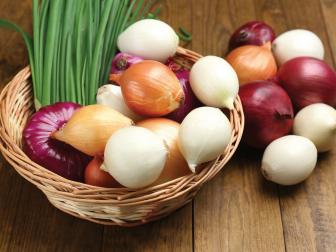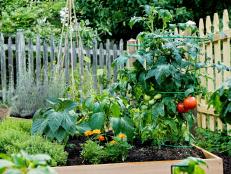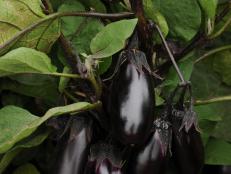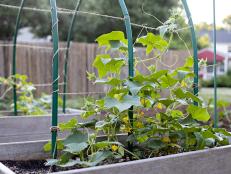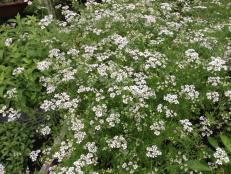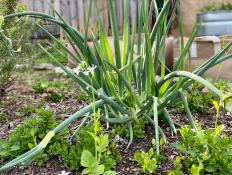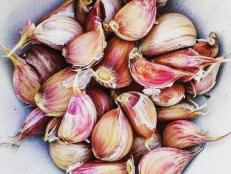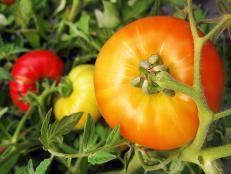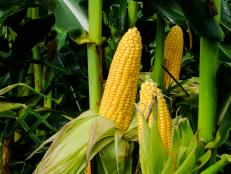Companion Planting for Onions
Onions are easy to grow and so ueful in the kitchen. Learn what other vegetables and herbs grow well with onions in the garden.

Flavorful and versatile onions are a staple in just about every kitchen. From the tender greens to the flavorful bulbs, onions are key ingredients in countless dishes. Onions are easy to grow in the garden or in containers, so cultivate homegrown onions to keep this staple close at hand. Experiment with companion planting to improve the flavor, yield, and health of your garden-grown onions.

Mary Kocol for Tower Hill Botanic Garden at TowerHillBG.org
Onion family plant members, including leek, chives, garlic, onion and shallots, pair perfectly with carrots because they repel carrot fly. The two crops also create a beautiful combination in the garden with contrasting leaf textures.
What is Companion Planting?
Cultivating a diversity of species in the vegetable garden will improve the health and productivity of your crops. Companion planting can repel pests, provide food and habitat for predators of pests, and even improve the flavor and size of your onions.
- Flowering insectary plants provide pollen and nectar for predators of onion pests. Although predators do eat pests like thrips and aphids, many predator species need to feed on flowers to sustain their populations. Insectary plants also attract pollinators for other vegetable crops.
- Trap crops are more attractive to pests than onions and provide a buggy buffet for predators such as parasitic wasps, lacewings, and ladybugs.
- Repellent plants repulse pests with natural compounds produced in their leaves, flowers, or roots. Aromatic plants like herbs, fragrant flowers, and even onions are often used as natural repellents.
- Cover crops enrich soil health by improving soil structure, adding nutrients and organic matter to the garden, feeding soil organisms, and providing food and habitat for beneficial insects. Grow cover crops in a fallow bed during the season before you plant the intended crop. Although some vegetables can be planted directly into the cover crop residue, onions will grow better if the cover crop is incorporated into the soil a few weeks before planting.
Companions for Onions
- Plant fenugreek with onion for larger, more flavorful bulbs.
- Grow onion with marigold, fennel, carrots, tomato, potato, peppers, or okra to increase yields and to limit thrips damage by either repelling thrips or by serving as a trap crop. Thrips damage onions by feeding on the foliage and by spreading destructive viruses between plants.
- Marigolds also discourage onion root maggot flies from laying their eggs on onion plants. Once the eggs hatch, the larvae will eat the onion roots, bulb, and stem.
- Try growing onions after a cover crop of winter rye. Bunching onions will grow more foliage and bulbing onions should produce larger bulbs. Although not all cover crops need to be tilled before planting, onions do grow better if the cover crop is mixed into the soil.

Staff for Tower Hill Botanic Garden at TowerHillBG.org
Savoy cabbage and onion is a classic vegetable companion planting combination. A bark path provides dry footing in the vegetable garden and helps keep edible leaves clean from splashing soil.
Onions as Companions
Onions are great companion plants for many other members of the vegetable garden. Onions and their relatives can make tomatoes more resilient against Verticillium wilt, repel aphids on potatoes, discourage spider mites on strawberries, repel carrot rust fly on carrots, and deter cabbage root flies on brassicas to name just a handful of examples. Even if you’re not the biggest fan of onions in the kitchen, it would be worthwhile to leave some room for the humble onion out in the garden.
Bad Neighbors for Onions
Beans, peas, cabbage, turnips, squash, cucumbers, and melons can harbor onion thrips. If onion thrips are a serious pest in your garden, give some space between onions and these crops.
Tips for Growing Onions

Julie Martens Forney
These full-size onions are ready for harvest.
There’s more than one way to grow an onion, and you can experiment with the method that works best in your garden. Onions can be grown from seed, sets (or small bulbs), and seedlings. They can even be regrown from kitchen scraps for smaller plantings. Long-day, short-day, or intermediate onions will set bulbs depending on what region they’re grown in and the planting date. Check with your local extension service to see what type of onions will grow best in your area and to learn when the best time to plant will be.
Traditional onions are biennial crops grown for just one season and harvested before blooming. However, low-maintenance perennial walking onions (or “tree onions”), multiplier onions, and shallots are growing in popularity.
Onions and their relatives grow best in fertile soil and full sun. During early spring weather, plants expend most of their effort putting on verdant new growth that will harvest energy from sunlight. When the planting begins to look crowded, thin every other plant to make room for bulbs to develop. Save the tender, flavorful thinned plants to use in the kitchen as spring onions.
How to Plant and Grow Onions
Get our tips on planting, growing and harvesting onions in your garden.
With warmer weather in the summer, plants will shift gears to bulb development. Onions are ready to harvest when the leaves turn brown and flop over. Cure the onions for storage by allowing them to dry out in the garden or under cover for a few days. When the outer skin becomes dry and papery, store disease-free onions in a cool, dry location until you’re ready to use them in the kitchen.
Tips for Crop Rotation
- Group onion with its relatives in the Amaryllidaceae family, including garlic, leeks, and chives. Related plants are often susceptible to the same pests and diseases. Grow these crops together and plant them in a different area of the garden each season to prevent eggs, fungal spores, and bacteria from building up in the soil.
- Onion thrips can feed on crops outside of the onion family including legumes, brassicas, and cucurbits (see “Bad Neighbors” above). Scout for thrips damage on susceptible crops and avoid planting onions and its relatives in plots where thrips have been a problem.






